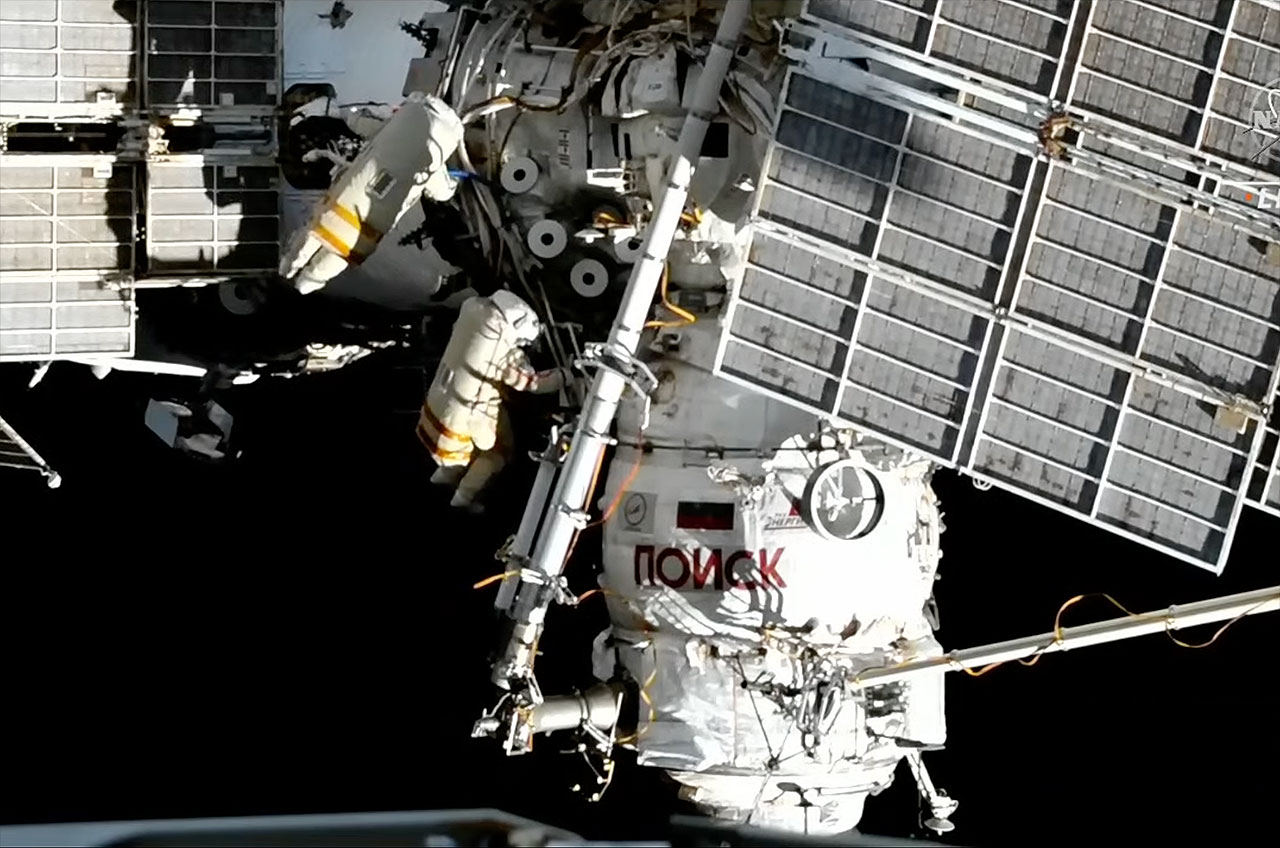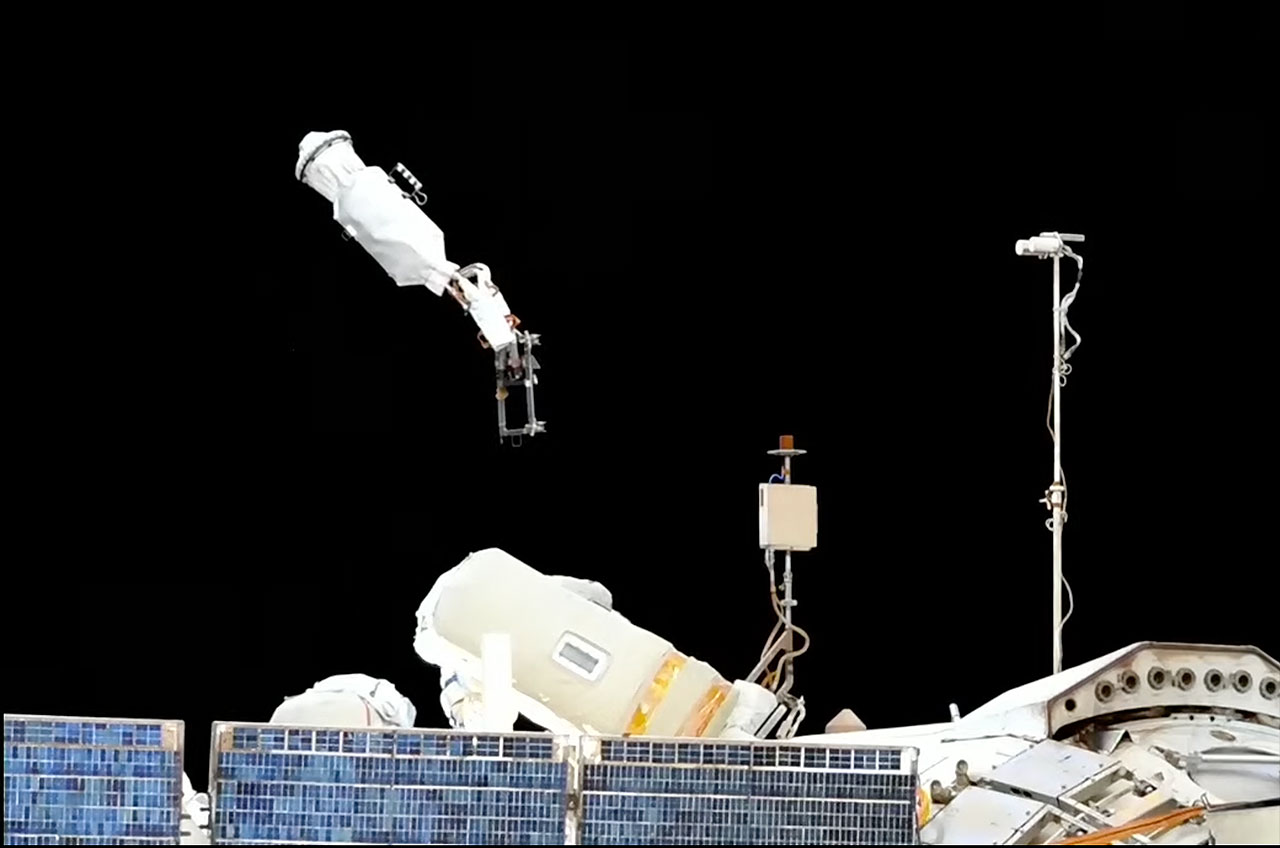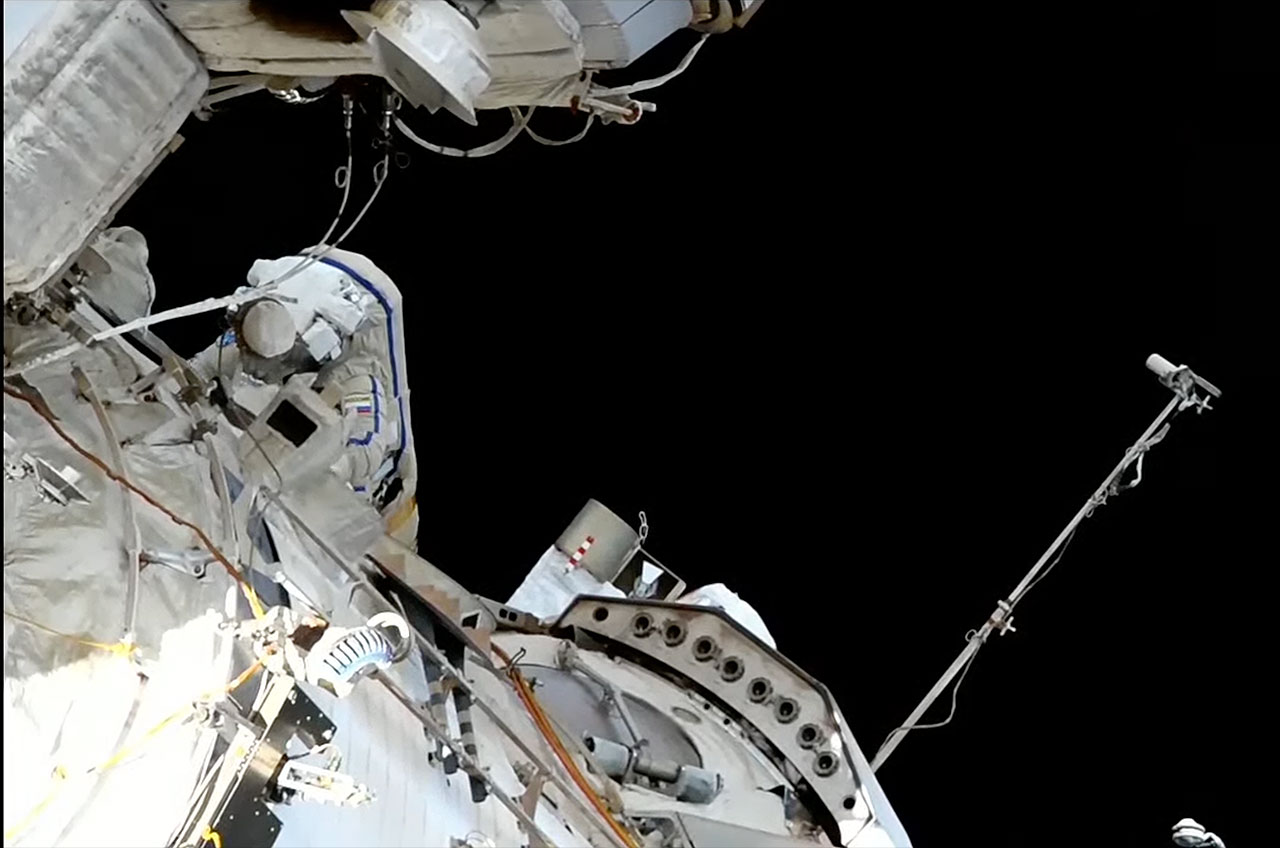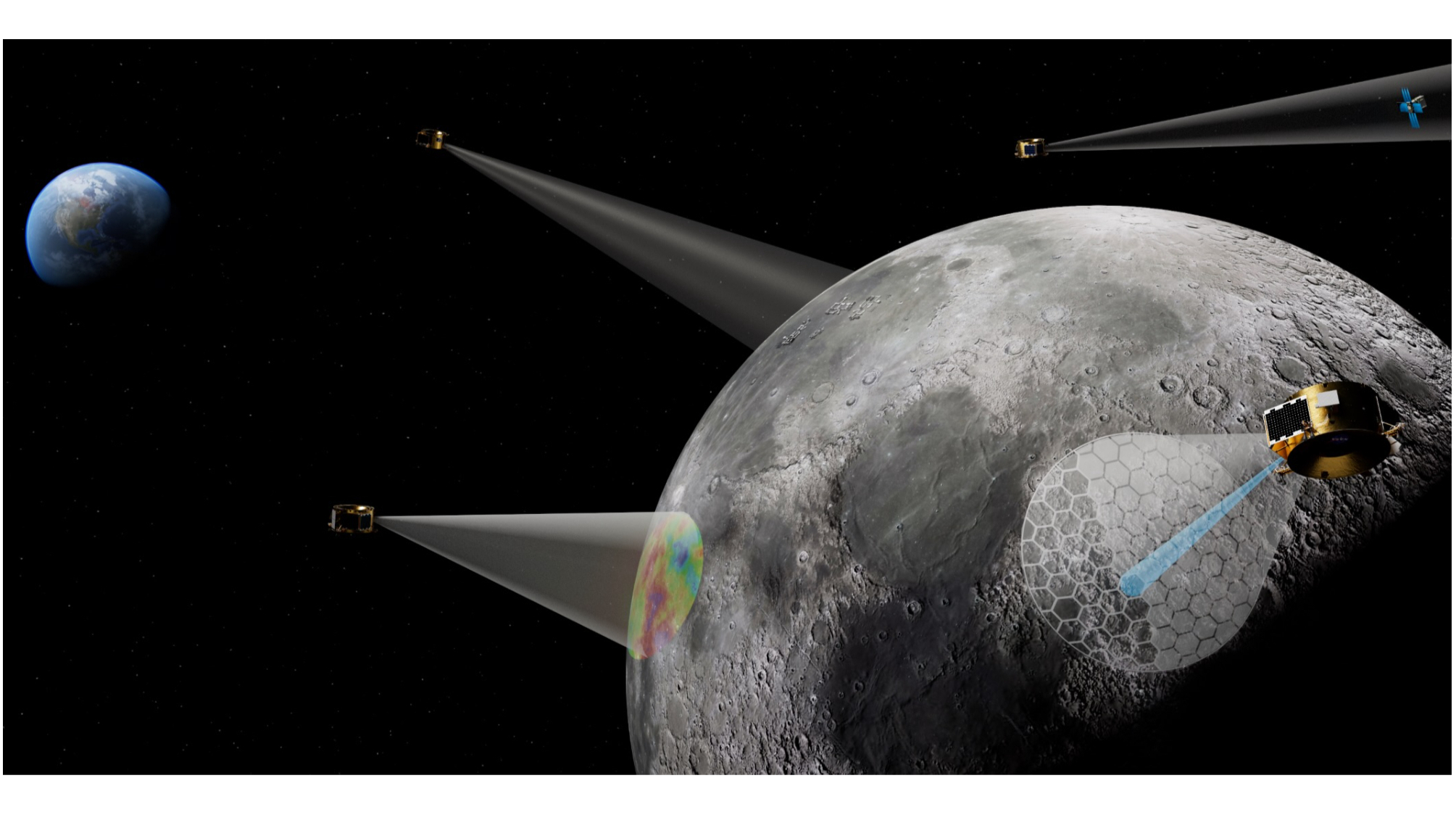Russian cosmonauts toss old equipment overboard on ISS spacewalk
'Wave goodbye to it. Rest in peace.'
Two Russian cosmonauts spent six hours outside the International Space Station on Thursday (June 22) cleaning up the exterior of the orbiting laboratory by removing and tossing overboard a trio of no longer needed devices, including a spent science experiment.
Expedition 69 commander Sergey Prokopyev and flight engineer Dmitry Petelin, both of Russia's federal space corporation Roscosmos, exited the space station's Poisk module at 10:24 a.m. EDT (1424 GMT) on Thursday.
In addition to jettisoning hardware, the spacewalk also included the installation of a new stanchion for high-speed telemetry equipment and the retrieval of a micrometeoroid impact experiment that had been mounted outside the space station for a number of years.
Related: The most memorable spacewalks of all time in pictures
Prokopyev and Petelin made quick work of rerouting cables and disconnecting a data relay unit and a telemetry transmitter, as well as the hardware for a completed experiment that measured seismic activity on Earth, before throwing each overboard for their eventual disposal, burning up in Earth's atmosphere.
"Wave goodbye to it," advised Mission Control Moscow, as Prokopyev prepared to toss one of the items into space. "Rest in peace."

The experiment, called the Seismoprognoz, had been installed outside the Zvezda service module during an Expedition 38 spacewalk on Dec. 27, 2013, almost 10 years ago. Like the communication units, the Seismoprognoz was tossed off the back of the space station in a direction that ensured that the gear could never make recontact with the outpost.
Breaking space news, the latest updates on rocket launches, skywatching events and more!
The jettisons, which also included the stanchions (or "monoblocks") that had held the equipment on Zvezda, made way for the installation of new hardware, including a mono block for a new high-speed data unit that Prokopyev and Petelin mounted on the module.

The two spacewalkers also photo documented the condition of the plume deflectors at the aft end of Zvezda service module for later analysis by Russian engineers on the ground. The deflectors shield the station from the plume of the module's engines. The inspection comes almost 23 years after Zvezda was launched atop a Russian Proton rocket in July 2000.
"It looks like a dirty frying pan," said Prokopyev. "That could have made some good fries in it."
"Well, it hasn't been washed for quite some time," replied Petelin.
The cosmonauts also captured high-resolution photography of the boom upon which a high-data antenna is mounted at the very aft end of the Zvezda service module.
The duo then moved to the opposite side of Zvezda to finish out their tasks for this spacewalk. They cleaned one of the module's windows using towels that they then also jettisoned and retrieved a final science experiment, a biological sample exposure package, located near the hatch to the Poisk airlock.

The spacewalk ended at 4:48 p.m. EDT (2048 GMT) with Prokopyev and Petelin back inside Poisk after working for 6 hours and 24 minutes in the vacuum of space.
With the completion of Thursday's spacewalk, Prokopyev has now logged 48 hours and 40 minutes on seven extravehicular activities (EVAs). Petelin has now conducted five spacewalks, all with Prokopyev, for a total time of 33 hours and 9 minutes.
The EVA was the was the ninth this year and the 266th dedicated to the assembly and maintenance of the International Space Station since 1998.
Join our Space Forums to keep talking space on the latest missions, night sky and more! And if you have a news tip, correction or comment, let us know at: community@space.com.

Robert Pearlman is a space historian, journalist and the founder and editor of collectSPACE.com, a daily news publication and community devoted to space history with a particular focus on how and where space exploration intersects with pop culture. Pearlman is also a contributing writer for Space.com and co-author of "Space Stations: The Art, Science, and Reality of Working in Space” published by Smithsonian Books in 2018.In 2009, he was inducted into the U.S. Space Camp Hall of Fame in Huntsville, Alabama. In 2021, he was honored by the American Astronautical Society with the Ordway Award for Sustained Excellence in Spaceflight History. In 2023, the National Space Club Florida Committee recognized Pearlman with the Kolcum News and Communications Award for excellence in telling the space story along the Space Coast and throughout the world.
-
David P L You can't just toss stuff overboard. They're just giving it a slightly different orbit, which will probably intersect with with the ISS in the future.Reply -
Pietko ehm... maybe not... because it will slowly deorbit due to highly rarefied atmosphere... Still it will continue slowly on lower and lower orbits in the course of a few years.Reply
I agree that this is not a good habit to litter around... -
Unclear Engineer It would have been useful if the article had given the projected remaining lifetime in orbit for the equipment that was "thrown away" as described. Presumably, it was pushed away in the opposite direction from the forward path of the ISS in its orbit. That would give it a more elliptical orbit, with its highest point being the ISS orbit and the lowest point getting closer to the atmosphere and increasing its drag while there. That drag reduces the high and low points in the junk's future orbits, until its low point gets to where it slows down enough to re-enter and burn-up. But, until then, it is a potential hazard to other, useful things in orbit, and should be tracked. So, how long is that period from jettison to burnup?Reply -
AltBren Would it be useful to have some kind of cannon, to eject the rubbish in a specific direction with a bit of welly.. it could be used to make adjustments to it's trajectory and ensure the rubbish isn't a space junk issue.Reply -
Pietko Reply
Deorbit takes about year from 400kmAltBren said:Would it be useful to have some kind of cannon, to eject the rubbish in a specific direction with a bit of welly.. it could be used to make adjustments to it's trajectory and ensure the rubbish isn't a space junk issue.
But it depends on a few factors. Overall mass and density of object, shape, solar activity...
Small, high density objects take long time to deorbit from that height.
Low density objects take short to deorbit... or they may be even pushed to interplanetary space(solar sail like very light objects with very large surface). -
wagonmaster Reply
And what will it run into on the way down? A three layered low orbit group of satellites. An old camping saying applies "Pack it in, Pack it out". All such materials should be returned back to the ground for disposalPietko said:ehm... maybe not... because it will slowly deorbit due to highly rarefied atmosphere... Still it will continue slowly on lower and lower orbits in the course of a few years.
I agree that this is not a good habit to litter around... -
Pietko Reply
We all know that russians do not care.wagonmaster said:And what will it run into on the way down? A three layered low orbit group of satellites. An old camping saying applies "Pack it in, Pack it out". All such materials should be returned back to the ground for disposal -
BenN Reply
So a couple of years to deorbit. They don't care but they should hear us complain.Admin said:Russian cosmonauts Sergey Prokopyev and Dmitry Petelin worked outside of the International Space Station to remove and toss overboard a trio of outdated devices, including a spent science experiment.
Russian cosmonauts toss old equipment overboard on International Space Station spacewalk : Read more -
billslugg If the astronauts pushed the debris backwards at, say, one meter per second, then by 1/4 of an orbit, it is already about 500 meters lower. At 2 km lower per orbit, it is not going to last very long, maybe a week or so.Reply -
HelpDPlanet Reply
I am a bit surprised that tossing stuff is a thing. If you look at a map of all of the junk orbiting around the planet, it is frightening. I guess "pack it in pack it out" is only for us landlubbers.David P L said:You can't just toss stuff overboard. They're just giving it a slightly different orbit, which will probably intersect with with the ISS in the future.
